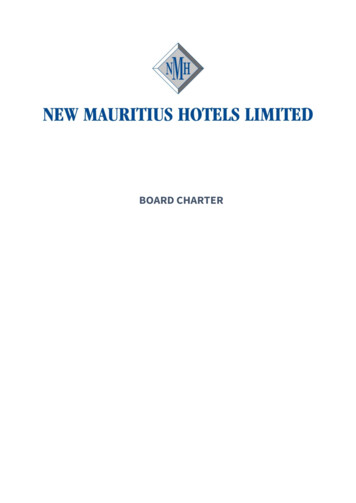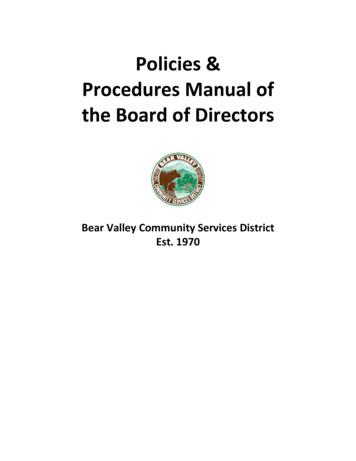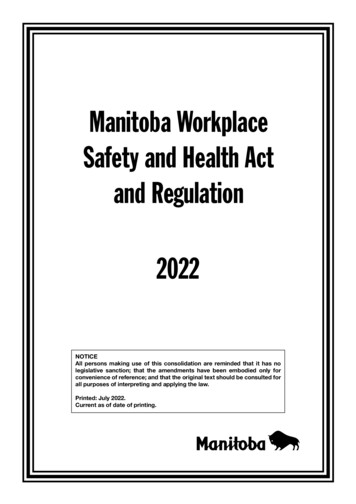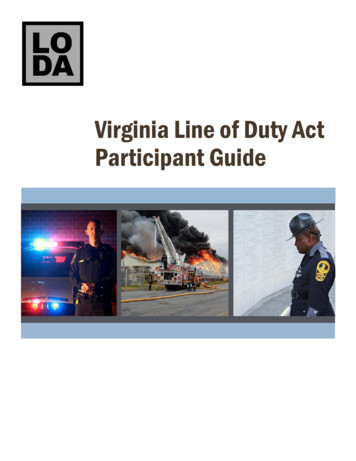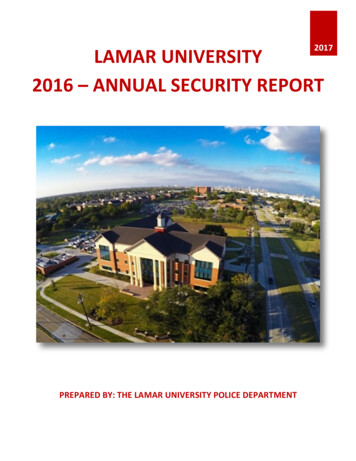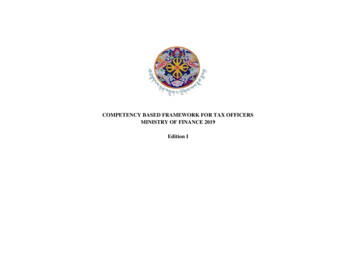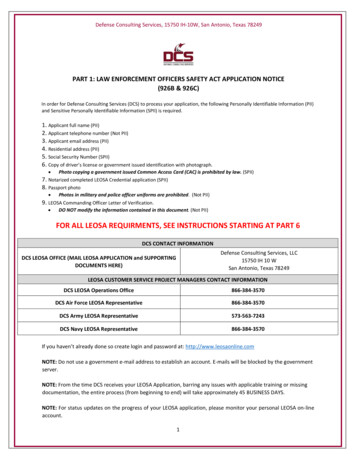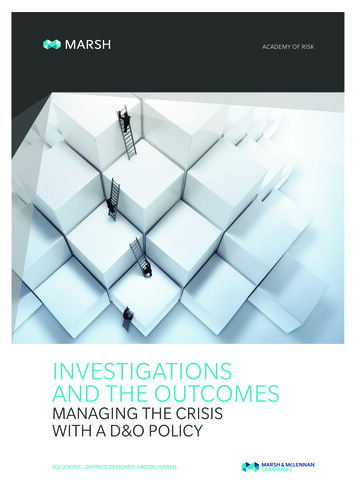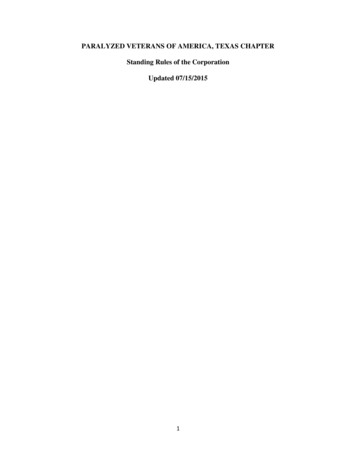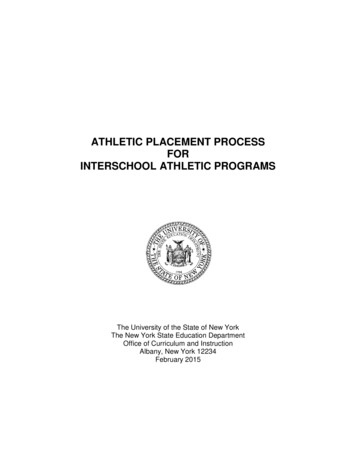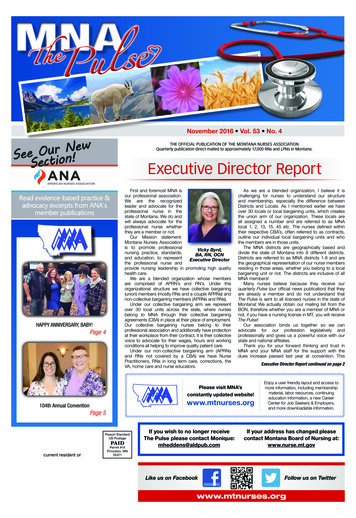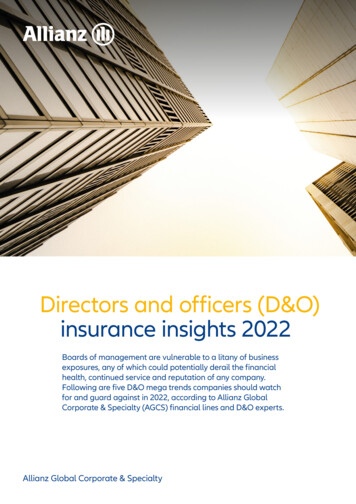
Transcription
Directors and officers (D&O)insurance insights 2022Boards of management are vulnerable to a litany of businessexposures, any of which could potentially derail the financialhealth, continued service and reputation of any company.Following are five D&O mega trends companies should watchfor and guard against in 2022, according to Allianz GlobalCorporate & Specialty (AGCS) financial lines and D&O experts.Allianz Global Corporate & Specialty
D&O INSURANCE INSIGHTS 2022AboutAGCSAllianz Global Corporate & Specialty(AGCS) is a leading global corporateinsurance carrier and a key businessunit of Allianz Group. We providerisk consultancy, Property‑Casualtyinsurance solutions and alternativerisk transfer for a wide spectrum ofcommercial, corporate and specialtyrisks across 10 dedicated linesof business.Our customers are as diverse asbusiness can be, ranging from FortuneGlobal 500 companies to smallbusinesses, and private individuals.Among them are not only the world’slargest consumer brands, techcompanies and the global aviationand shipping industry, but alsosatellite operators or Hollywood filmproductions. They all look to AGCSfor smart answers to their largestand most complex risks in a dynamic,multinational business environmentand trust us to deliver an outstandingclaims experience.Worldwide, AGCS operates with itsown teams in more than 30 countriesand through the Allianz Groupnetwork and partners in over 200countries and territories, employingaround 4,400 people. As one of thelargest Property‑ Casualty units ofAllianz Group, we are backed bystrong and stable financial ratings.In 2020, AGCS generated a total of 9.3bn gross premium globally.www.agcs.allianz.com21. Uncertaininsolvencyoutlookcontinues toconcernMany different projections were made during 2020 aboutthe impact Covid-19 would have on the global economy,particularly with regards to anticipating an increase inthe number of insolvencies. Those predicting a decreasein the number of insolvencies by the end of 2020 were inthe minority, but this is, in fact, what happened. The EulerHermes Global Insolvency Index1 ended 2020 with a -12%y/y drop, following a steady decline through the year.At the end of 2021 the Euler Hermes index is expected toclose at -6% y/y. From a US bankruptcy filing perspective,according to Cornerstone Research2 , in the first half of2021 43 companies filed for bankruptcy, less than half ofthe number of bankruptcies filed in 1H 2020, but slightlyabove the 2005-2020 annual average of bankruptcy filings(based on Chapter 7 and Chapter 11 filings for private andpublic companies with over 100mn in assets).From a D&O underwriting standpoint, this recent trendon insolvencies could eventually lead underwriters orinsurance buyers to expect a relaxing of terms andconditions next year compared with what the expectationswere for 2022 a year ago. However, the reality is that largestate interventions took place in many countries to supportcompanies, preventing a liquidity crisis. Therefore theimpact of the phasing out of these measures still remains aconcern for D&O underwriters.1 Allianz Research, Euler Hermes, “Insolvencies: We’ll be back”, October 6, 20212 Cornerstone Research “Trends in Large Corporate Bankruptcy and FinancialDistress: Midyear 2021 Update”
D&O INSURANCE INSIGHTS 2022Global insolvency index –quarterly changes y/y in Q2Q32019Q4Q1Q2Q32020-18%-19%Q4Q1Q22021Source: Euler Hermes, Allianz ResearchWhile the first signs of this relaxation in governmentalsupporting measures are already underway around theworld, significant uncertainty remains around potentialnew future virus dynamics, vaccination rates, the generalmacroeconomic environment and the response of centralbanks, and, equally, what the impact of these factors willbe on capital markets.The recent Allianz Research/Euler Hermes publishedreport states that “Our Global Insolvency Index would posta 15% y/y rebound in 2022, after two consecutive yearsof decline (- 6% in 2021 and -12% in 2020), but businessinsolvencies would still remain below pre-Covid-19 levels ina majority of countries (by -4% in average).”Mixed trends are expected across the world. In lessdeveloped markets, such as Africa or Latin America, thenumber of insolvencies is expected to increase quickercompared to more developed economies, such asFrance, Germany and the US, where the impact of thegovernmental support is expected to last for longer.Historically, insolvency is a major cause of D&O claimsas insolvency practitioners look to recoup losses fromdirectors. There are many ways that stakeholders could goafter directors following insolvency, such as alleging thatboards failed to prepare adequately for a pandemic or forprolonged periods of reduced income.At the same time recent bankruptcy cases can remain inD&O underwriters’ memories for a long time. Prominentexamples in 2021 are US bankruptcy filings, such asdrillship owner Seadrill Limited and retail property ownerWashington Prime Group, Inc. Meanwhile, the near-collapseof Chinese property giant Evergrande generated headlines.“Insolvency exposures remain a key topic in the D&O spaceand underwriters are increasingly looking into forwardlooking key performance indicators and predictivemodeling tools,” says Shanil Williams, Global Head ofFinancial Lines at AGCS. As part of a broader Allianz dataand expertise sharing collaboration, D&O underwritersat AGCS are actively using the Euler Hermes InsolvencyGrade. “This provides a one-year probability of bankruptcyand is an integral part of the D&O risk assessment atAGCS,” adds Williams.3
D&O INSURANCE INSIGHTS 20222. SPACs exposuregrows for D&OsOffering anew, moreefficient routeto publicmarkets,SPACs alsocarry a setof specific‘insurancerelevant’ risks4Although Special Purpose AcquisitionCompanies (SPACs) have been aroundfor decades, 2020 was a breakoutyear. This surge grew into a highoctane investment in early 2021,accounting for more than 50% of newlypublicly-listed US companies. Duringthe first half of 2021, the numberof SPAC mergers, both announcedand completed, more than doubledthe full year total of 2020 with 359SPAC filings, garnering a combinedUS 95bn raised1 . In Q1 2021 alone,there were 298 SPAC filings raisingup to 82.8bn. However, in Q2 2021,the number plummeted to 61 filingsin the US with only 11.9bn raised.The slowdown is considered mainlya result of pronouncements by theSecurities Exchange Commission (SEC)to increase scrutiny on SPACs, forexample, by issuing new accountingrules now classifying SPAC warrants asliabilities instead of equities.It is a different story across the restof the world. The growth of SPACs inEurope may not match the scale of theUS boom, but there is still a growingexpectation that it will increase. Thereare only limited obstacles presentedby EU capital market laws, eventhough SPACs in the EU face somechallenges because of strict companylaw requirements. In the Asianfinancial hub, the market is slowlygaining momentum with a significantuptick in companies in China, HongKong and Singapore as a new route toaccessing capital markets.1 CB Insights, What is a SPAC? July 14, 20212 Katten, 2021 SPAC survey reportSPACs, also known as ‘blank checkcompanies’, represent a faster trackto public markets with a less arduouspath for companies looking to gopublic. Advantages and conditionsfueling the growth of SPACs overtraditional Initial Public Offerings(IPOs) include smoother procedures,less regulatory and process burdens,shorter timelines to complete amerger with target companies (60to 90 days versus six to 12 monthsbetween the initial filings and thepublic offering for traditional IPOs),low interest rates and an increasedavailability of capital sources.So far the SPAC boom has beenlargely concentrated in high-growthindustries such as technology,financial services and healthcare.Since 2019, in the US, 82 SPACs haveformed into target companies intechnology2 – far more than in anyother sector.As the playing field is still flooded withpursuant SPACs and the demand fortargets remains strong, the increasedmomentum of SPAC activity isexpected to remain the same through2022 outside of the US. It is also key towatch the sustainability and longevityof merger activities over the mediumto long-term horizon.
D&O INSURANCE INSIGHTS 2022SPAC filings and total raisedQ1 2018 to Q2 2021Total raised bnQ1 Q2 Q3 Q42020Q1 Q22021US SPACs as % of IPOsby market value andnumber of companies– Market value – Number of companies70%60%50%40%30%20%10%0%2009 2010 2011 2012 2013 2014 2015 2016 2017 2018 2019 2020 2021Source: BloombergIndustries to experience uptick inSPAC activity50%40%30%20%10%InsuranceConsumerReal estateIndustrials andmanufacturingEnergyLeisure/hospitality rger the risk of the go-forwardcompany to perform as expected orfailure to comply with the new dutiesof being a publicly-listed companyare among the other emerging riskson the SPACs radar that need tobe considered.Q1 Q2 Q3 Q420193002702402101801501209060300Source: CB InsightsFinancialservicesWhile being able to use a newmore efficient route to publicmarkets, SPACs carry a set ofspecific ‘insurance-relevant’ risks,and losses are already reportedto be flowing through to theD&O market. “Depending onthe type of insurance for eachstage of their lifecycle, inherentexposures could potentiallystem from mismanagement,fraud or intentional and materialmisrepresentation, inaccurate orinadequate financial information orviolations of SEC rules or disclosureduties,” explains Lydia Miller,Global Underwriting and ProductAnalyst at AGCS. “In addition, afailure to finalize the transactionwithin the two-year period, insidertrading during the time a SPAC goespublic, a wrong selection of a targetto acquire or the lack of adequatedue diligence in the target companycould also come into play.”FilingsQ1 Q2 Q3 Q42018TechnologyAs the SPAC market develops, theinsurance market also changes andadapts coverage solutions to provideadequate protection for the keyparticipants (sponsors, directors andshareholders) in a SPAC deal.1009080706050403020100Source: Katten 2021 SPAC survey report5
D&O INSURANCE INSIGHTS 20223. Market, climate changeand digital issues for financialservices companiesMore andmore banksand insurersare expectedto assignindividualresponsibilityfor overseeingfinancialrisks arisingfrom climatechangeThe financial services industrycontinues to face multiple challengesin terms of risk management. Onthe financial side, markets are likelyto become more volatile with theincreased risk of asset bubbles andinflation rising in different parts ofthe world.The general assumption is thatmonetary policies will harden, whilethere remains uncertainty regardingeconomic recovery levels in view ofrising energy prices and supply chaindisruptions. The impact of China, withits struggling real estate market andits regulatory interventions in sectorssuch as technology, should not beunderestimated.At the same time, importantinternational initiatives are underwayto develop more sustainable, resilientand circular economies in responseto the challenges posed by climatechange and global warming.The financial services sector has acritical role to play in achieving thisaim by helping to ensure that capitalflows toward sustainable projectsand assets with consideration ofenvironmental, social and governance(ESG) factors, according to DavidVan den Berghe, Global Head ofFinancial Institutions at AGCS.6As such, an increasing number offinancial institutions have alreadycommitted to aligning their lendingand investing portfolios to thisgoal, while management tools thatallow for active measurement of theexposure are being developed.Recent natural catastrophe eventssuch as wildfires in Southern Europeand California and floods in Germany,the US and China have emphasizedthe importance for regulators to focuson climate change and the impact oncredit risk (including stress tests).More and more banks and insurersare expected to assign individualresponsibility for overseeing financialrisks arising from climate change,while investors are paying closerattention to the proper disclosure ofthe risk that it poses for the companyor financial instrument they investin, as demonstrated by a number ofrecent actions (see column, page 7).Regulatory change to suitabilityrules are on their way to ensurethat investors’ ESG preferences aretaken into consideration during theinvestment advice process.
D&O INSURANCE INSIGHTS 2022“Therefore firms will face a numberof challenges, from obtainingclients’ ESG preferences to reducingregulatory risk including the risk of‘greenwashing’, where companiesmake false or misleading ESG claims,all of which could impact D&Os,” saysVan den Berghe. “Businesses shouldensure they have clear processes inplace for managing and disclosing theimpact to their business of ESG riskssuch as climate change.”Meanwhile, following the Covid-19pandemic, digitalization has furtheraccelerated – by as much as sevenyears according to a McKinseysurvey1 – and information andcommunications technology (ICT)plays an indispensable role in theoperation of the daily functions offinancial institutions. Digitalizationcovers not only payments, butalso lending, securities clearingand settlement, trading, insuranceunderwriting, claims managementand back office operations.Finance has not only become largelydigital, but digitalization has alsodeepened interconnections anddependencies within the sector andwith third-party infrastructure andservice providers.For firms’ senior managementthis requires them to maintain anactive role in steering the ICT riskmanagement framework. Thisencompasses the assignment ofclear roles and responsibilitiesfor all ICT-related functions, acontinuous engagement in thecontrol of the monitoring of theICT risk management, as well asan appropriate allocating of ICTinvestments and trainings.All these aforementioneddevelopments create additionalchallenges for the risk professional. IfICT risks are not properly managedthe company may experience servicedisruptions which could result inincreased operating expensesresulting from a variety of causesincluding customer redress, additionalconsultancy costs, loss of income andregulatory fines.Brand reputation would also likelybe affected as well, particularly if thecompany has been targeted by cybercriminals as a result, which couldultimately impact on the company’sstock price.“AGCS regularly engages in opendialogues with the banking, insuranceand asset management segments todiscuss risk trends and challenges,”says Van den Berghe. “We areinvesting heavily in our network andexpertise, both on the underwriting,claims and operations side, so we canbest respond to customers’ needs andcontribute to a better management ofrisks in a complex environment thatconstantly evolves.”1 McKinsey & Company, How Covid-19 has pushed companies over the technology tipping point – andtransformed business forever, October 20202 Clifford Chance, Climate Change test case settles: 57bn Australian super fund responds to pressure onclimate change policy3 MinterEllisonRuddWatts, 2021 Litigation Forecast – Climate change litigation: New risks for companiesand directorsPressureincreasingto discloseclimate riskClimate change litigationis beginning to targetfinancial institutions. Caseshave tended to focus onthe nature of investments,although there is a growinguse of litigation seeking todrive behavioral shifts andforce disclosure debate.In November 2020, a casewas settled involving a 57bn superannuationfund in Australia, Rest 2 .The claimant allegedRest’s failure to discloseand address climate riskbreached legislation. Thefund committed to a raftof new disclosure andclimate change-relatedinitiatives in response.In July 2020, a claim 3lodged in the FederalCourt of Australia allegedAustralian investors tradingin Government bondswould face “material risks”because of the AustralianGovernment’s responseto climate change andthis was not disclosedto investors. This case isongoing.7
D&O INSURANCE INSIGHTS 20224. Heightened USlitigation risk fornon-US domiciledcompaniesA surge of new lawsuit filings, the recentopenness of certain courts to extending longarm jurisdiction, and a possibly record-breakingsettlement announced in October 2021, pointto heightened US litigation risk for directors andofficers of non-US domiciled companies.In recent years shareholders increasingly havesought to avail themselves of US courts to bringderivative actions on behalf of non-US domiciledcorporations. In particular, since early 2020, agroup of plaintiffs’ firms has brought arounda dozen derivative lawsuits in New York Statecourts on behalf of shareholders of non-UScompanies seeking to hold directors and officerslegally and financially accountable for variousbreaches of duty to the corporations they havebeen engaged to serve.While not without precedent, such suits wereuncommon previously. Even when filed, derivativesuits brought on behalf of non-US companiesgenerally met resistance from US courts and weredismissed on jurisdictional and other grounds.However, certain recent court decisions makeclear that under the right circumstances, UScourts are willing to entertain such lawsuits.81 Justia US Law, Davis v. Scottish Re Group Ltd.2 Justia US Law, Mason-Mahon v FlintAmong the reasons given in the past by UScourts to dismiss a derivative suit against anon-US company was the failure of plaintiffsto comply with a requirement in the subjectcompany’s home jurisdiction – that theplaintiffs first apply for, and be granted, leavefrom a local court before pursuing a derivativeclaim. Such requirements typically don’t existin the US. However, in a series of decisions overthe past four years, courts in New York haveruled that such requirements are proceduralrather than substantive.While courts may be required to apply thesubstantive law of the place where a companyis incorporated when adjudicating the dutiesand liabilities of directors and officers, NewYork courts have ruled that their ability tohear a dispute should not be constrained byprocedural rules inconsistent with New Yorklaw and practice. See, for example, Davis v.Scottish Re Grp. Ltd., (2017)1; Mason-Mahon v.Flint (2018) 2 .
D&O INSURANCE INSIGHTS 2022Litigating in the US, derivative plaintiffs mayobtain advantages not available should theyattempt to bring suit in the company’s homecountry, not the least of which is possibly beingthe right to bring suit at all. The US permitscontingency fee arrangements for legal expensebut, with limited exception, does not permit thewinning party to recover its litigation expensefrom the losing party. As a result, the financialhurdles to bring suit in the US are significantlylower than in many other countries. In addition,US courts (and juries) are considered moreplaintiff-friendly than courts in many otherjurisdictions around the world.“The consequences to directors and officersforced to defend themselves in derivativelitigation before US courts can be severe,” saysDavid Ackerman, Global Claims Key CaseManagement at AGCS. In what may turn out tobe a record-setting settlement for a US derivativelawsuit, in October of this year defendantsagreed to pay a minimum of US 300mn3 tosettle litigation brought in New York State courtby shareholders of Renren, a social mediacorporation based in China, and incorporatedin the Cayman Islands, after allegations ofcorporate misconduct.The consequences todirectors and officersforced to defendthemselves in derivativelitigation before US courtscan be severeThis settlement followed the decision of a NewYork intermediate court of appeals affirmingthe rejection by the trial court of jurisdictionalchallenges to bringing the suit in New York.Of note, the court found that it had personaljurisdiction over the defendants due to theirsignificant activities in New York, includingconduct of an IPO of Renren shares on the NewYork Stock Exchange and the engagement of NewYork legal and banking advisors for this purpose,as well as the repeated consent of Renren tobe governed by New York law in regard tocontractual matters. See In re Renren, Inc. (2021)4 .3 Financial Times, US-listed Chinese group Renren settles investor complaint for 300mn, October 10, 20214 Reid Collins, In re Renren Inc. Derivative Litigation, Index No. 653594/20189
D&O INSURANCE INSIGHTS 20225. Increased risk ofshareholder derivativesuits under CaremarkIn 1996, in In re Caremark Int’l1 , the DelawareChancery Court in the US set the standards forclaims against corporate directors for lack ofboard oversight.In a derivative action, shareholders of healthservices company Caremark InternationalInc., alleged that the company’s directors, inneglecting to effect sufficient internal controlsystems, had breached their duty of care.It was because of this, the civil action alleged,that Caremark employees were able to commitcriminal offenses that resulted in the companyhaving to make reimbursements to variousprivate and public parties of more than 250mn2 .The court determined that boards of directorshave a duty to ensure that the corporation’sreporting system is adequate to assure thatappropriate information comes to the boardin a timely manner. Failure to do so can meanthat individual directors have liability forcorporate failures.Until recently there was a very high standardfor shareholders to prove that a board hadbreached this duty. They had to either show that:Either of these theories required a “showing thatthe directors knew they were not dischargingtheir fiduciary obligations.”, as in Stone v Ritter,2006. 3, which saw a group of shareholdersbring a derivative suit against AmSouth bank’sdirectors for failure to engage in properoversight of its Bank Secrecy Act and antimoney laundering policies and procedures,after it had been fined 50mn for failing toreport suspicious financial activity. Applying theCaremark standard, the Delaware ChanceryCourt dismissed the shareholders’ complaint.Very few cases have survived Motions toDismiss Caremark claims; therefore, they havehad a low settlement value. Those that havesurvived have settled for increasingly higheramounts however. For example, the WellsFargo shareholder derivative suit4 , filed inresponse to bank employees creating millionsof unauthorized customer accounts, settled for 240mn after denial of the Motion to Dismiss(based on 2.5bn in alleged loss); the McKessonderivative litigation5, which alleged the boardhad breached its fiduciary duties with respect tooversight of its opioid drug operations, settledfor 175mn after denial of the Motion to Dismiss(based on 3.95bn in alleged loss).1. the directors utterly failed to implementany reporting or information systems orcontrols or:2. having implemented such a system orcontrols, they consciously failed to monitor oroversee its operations.101 Case Briefs, In re Caremark International Inc. Derivative Litigation2 Justia US Law, In Re Caremark Intern. Inc. Deriv. Lit.3 Quimbee, Stone v. Ritter Delaware Supreme Court, 2006 WL 302558 , 911 A.2d 362 (Del. 2006)4 The D&O Diary, Massive settlement in Wells Fargo bogus account scandal derivative suit, March 3, 20195 The D&O Diary, McKesson opioid-related derivative suit settles for 175mn, February 6, 20206 Lexis Nexis, Marchand v. Barnhill - 212 A.3d 805 (Del. 2019)
D&O INSURANCE INSIGHTS 2022The very high standard for Caremark claims wasapparently lowered in 2019 when the DelawareSupreme Court decided Marchand v. Barnhill6 .In this case, shareholders of food company BlueBell brought a derivative claim under Caremarkafter a listeria outbreak resulted in the death ofthree customers, a nationwide recall, a liquiditycrisis and emergency credit facility that dilutedshareholders’ control of the company.The Marchand court focused on the fact thatBlue Bell manufactured only one product, icecream, and therefore food safety was missioncritical to the corporation. Despite this, Blue Bellhad no board committee to address food safety,had no regular discussion of safety issues, andapparently did not receive certain negativereports about food safety.Following the denial of the Motion to Dismiss,the Bluebell shareholder derivative suit settledfor 60mn (based on 453mn in alleged loss).This settlement was 13% of the alleged loss asopposed to 4.4% for McKesson and 6.9% forWells Fargo.“Since the Marchand decision, an increasingnumber of Caremark claims are survivingMotions to Dismiss, potentially leading togreater exposure for individual corporatedirectors,” says Angela Sivilli, GlobalPractice Group Leader, CommercialManagement Liability and FinancialInstitutions, Chief Claims Office at AGCS.“Board members must accordingly reexamine whether there is sufficient Side Acover (which covers liabilities incurred by anindividual in their capacity as a director orofficer) in their D&O insurance program.”11
D&O INSURANCE INSIGHTS 2022Market dynamicsthe state of the D&Oinsurance sectorFind out more aboutthe virtual captivemarket articles/virtualcaptives.htmlBillions of dollars of premiums are collectedannually for D&O insurance but the profitabilityof the sector has suffered in previous yearsbecause of increasing competition, the growingnumber of lawsuits and rising claims frequencyand severity. Underwriting results have beennegative in many markets around the world,as event-driven litigation, collective redressdevelopments, regulatory investigations andhigher defense costs have taken their toll.Therefore, the overall market hardening trendhas continued through past quarters, withgenerally higher premiums, tighter terms andselective deployment of capacity for bothprimary and excess layers.Global insurance pricing for D&O has previouslyshowed double-digits increase in all keymarkets in 2021, according to third party data.However, as the year has progressed it has beenreported that there was some deceleration inthe premium increases compared to the “Covid”year 2020.1 Marsh Global Insurance Markets: Pricing increases moderate in second quarter, July 2021D&O Insurance StructureThe structure of a D&O insurance policy depends on which of three insuring agreements are purchased (ABC policies aregenerally chosen, as these are standard form policies for publicly listed companies; for private or non-profit companies,only AB policies would be useful).CoverDescriptionWho is the insured?What is at risk?Side AProtects assets of individual directors andofficers for claims where the companyis not legally or financially able to fundindemnificationIndividual officerHis/her personal assetsSide BReimburses public or private company tothe extent that it grants indemnificationand advances legal fees on behalf ofdirectors/officersCompanyIts corporate assetsSide CExtends cover for public company (the entity,not individuals) for securities claims onlyCompanyIts corporate assets12
D&O INSURANCE INSIGHTS 2022Regionally there are some important differencesto observe. Financial and professional linesrates increased 25% in the US, driven by D&Oliability and cyber pricing, according to Marsh1 ,whereas financial and professional lines in theUK saw pricing up by 57%, largely due to D&O.Continental Europe, Latin America and Asiafollowed by respectively 20%, 22% and 24%.US-listed companies (including Initial Publicofferings), as well as pharma, tech, life scienceand retail organizations are still experiencingconsiderable rate pressure and retention levelsfor side B and C coverages.From an insurance-purchasing perspective,capacity levels are still not at the soft marketlevels seen prior to 2018, despite the fact that anumber of new insurers have entered the D&Omarket. This means there is still an imbalancebetween supply and demand and manycompanies would like to purchase more limitsthan the industry can currently offer.The hard market conditions are promptingmore discussion around alternative risk transferand finance and companies are increasinglyexploring solutions such as the utilizationof (virtual) captives for the side C portion ofthe coverage.
ContactsFor more information contact your local Allianz Global Corporate & Specialty Communications team.Asia PacificWendy Kohwendy.koh@allianz.com 65 6395 3796Central and Eastern EuropeDaniel Aschoffdaniel.aschoff@allianz.com 49 89 3800 18900Ibero/LatAmCamila Corsinicamila.corsini@allianz.com 55 11 3527 0235Mediterranean/AfricaFlorence Claretflorence.claret@allianz.com 33 158 858863North AmericaEmil Janssensemil.janssens@agcs.allianz.com 1 212 553 1287Lesiba Sethogalesiba.sethoga@allianz.com 27 11 214 7948UK, Middle East, NordicsAilsa Sayersailsa.sayers@allianz.com 44 20 3451 3391GlobalHugo Kidstonhugo.kidston@allianz.com 44 203 451 3891Heidi Polke‑Markmannheidi.polke@allianz.com 49 89 3800 14303For more information contact agcs.communication@allianz.comFollow Allianz Global Corporate & Specialty onTwitter @AGCS Insurance #directorsandofficersinsurance andLinkedInwww.agcs.allianz.comThank you to Joana Moniz for her contribution to this report.Disclaimer & CopyrightCopyright 2021 Allianz Global Corporate & Specialty SE. All rights reserved.The material contained in this publication is designed to provide general information only. While every effort has been made to ensure that the information provided is accurate, this information isprovided without any representation or guarantee or warranty of any kind about its accuracy and completeness and neither Allianz Global Corporate & Specialty SE, Allianz Risk Consulting Gmbh,Allianz Risk Consulting LLC, nor any other company of Allianz Group can be held responsible for any errors or omissions. This publication has been made on the sole initiative of Allianz GlobalCorporate & Specialty SE.All descriptions of services remain subject to the terms and conditions of the service contract, if any. Any risk management d
concern for D&O underwriters. Allianz Global Corporate & Specialty (AGCS) is a leading global corporate insurance carrier and a key business unit of Allianz Group. We provide risk consultancy, Property-Casualty insurance solutions and alternative risk transfer for a wide spectrum of commercial, corporate and specialty risks across 10 dedicated .

